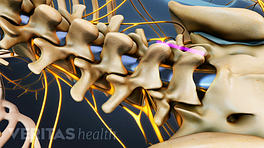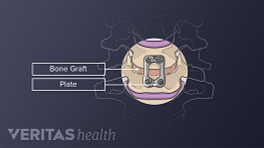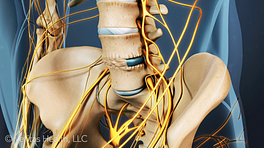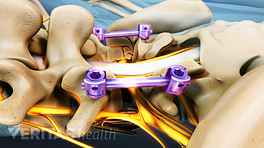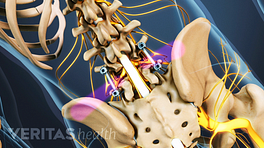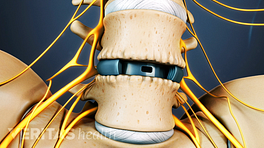A posterior lumbar interbody fusion, called a PLIF, is a surgery designed to stop the motion at the targeted segment of the spine.
A PLIF is done in the lumbar, or lower, spine. Most commonly it is performed on the L4-L5 or L5-S1 segment at the bottom of the lumbar spine.
This surgery may be done to treat lumbar degenerative disc disease, in which a degenerated disc becomes painful. It may also be done for a lumbar spondylolisthesis, in which one vertebra slips forward over the vertebra below it.
A PLIF starts with a three to six-inch long incision in the midline of the back.
Next, the lower back muscles, called erector spinae, are stripped off the lamina on both sides and at multiple levels.
The lamina is removed, which allows visualization of the nerve roots.
The facet joints, which are directly over the nerve root, may then be trimmed to give the nerve roots more room.
The nerve roots are then retracted to one side and the disc space is cleaned of the disc material.
Some type of implant, called a cage, is then inserted into the disc space. The cage helps restore more of the normal spacing in between the vertebrae, alleviating pressure on the nerve roots.
Bone graft is placed in the cage and along the sides of the spine.
There are many bone graft options. If the patient's own bone graft is used, bone morsels are harvested from the patient's iliac crest, along the back of the hip.
This is an additional surgical procedure that is done at the same time as the fusion surgery.
Bone that has been removed from a laminectomy may also be used, or synthetic bone graft options may be used.
The surgeon may implant a series of screws and rods to the back of the spine for additional support.
A PLIF fusion may be supplemented by a simultaneous posterolateral spine fusion surgery.
In addition to open surgery, a PLIF may sometimes be done through a tube in a minimally invasive approach.
In This Article:
- Posterior Lumbar Interbody Fusion (PLIF) Surgery
- PLIF Potential Advantages and Disadvantages
- Posterior Lumbar Interbody Fusion (PLIF) Video

